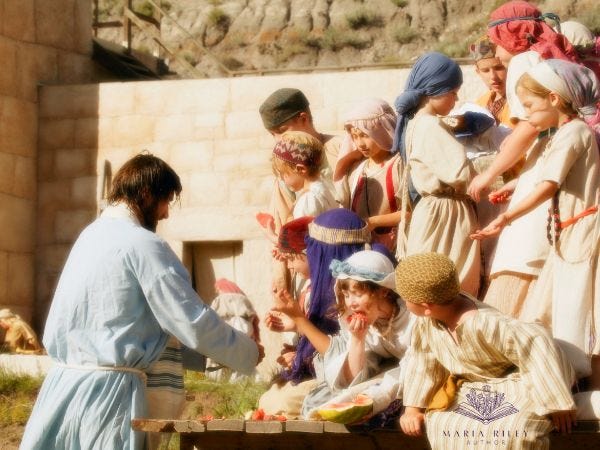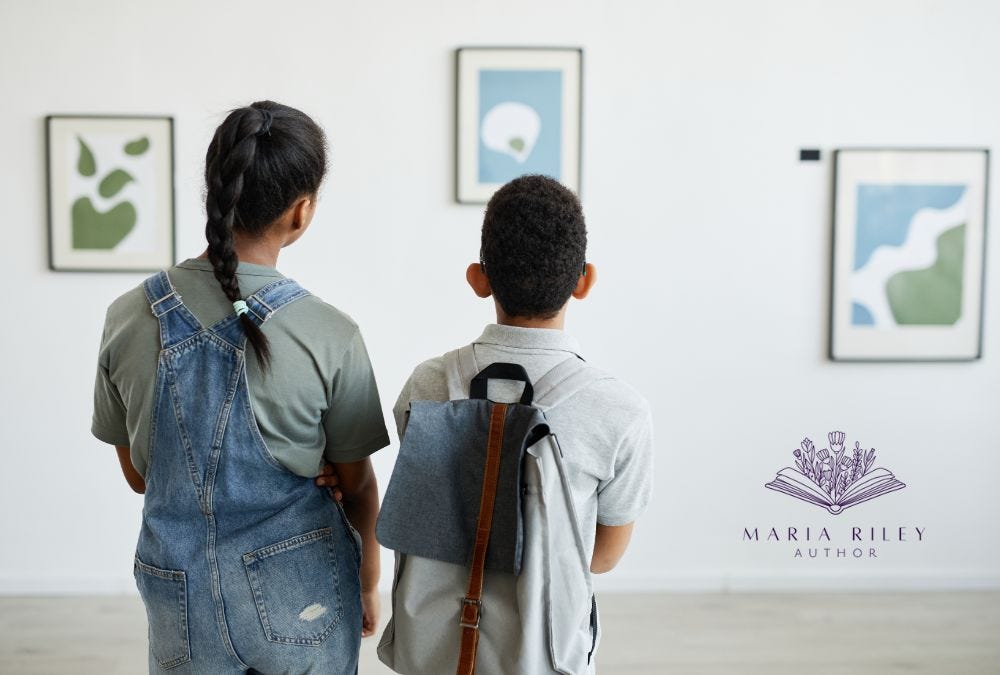Family Prayer Series #3: Family Visio Divina
In this third installment of the Family Prayer Series, Maria Riley unpacks the beautiful prayer of visio divina, the perfect addition to your family's prayer life.
This week I’m in the throes of after school pandemonium. My daughters are each allowed to participate in one extracurricular activity, and they are all starting up this week! On top of that, our parish wide religious education program launches this week, so all of a sudden, my evenings are back to being scheduled up.
I believe in (at least attempting) balance in all things, which is why I limit my girls’ participation to just one thing each. If I let them, they’d have after school commitments every day of the week. I feel blessed to have kids who love to draw, act, flip, throw, climb, play, and spend time with peers all the time. But my role as their mother requires me to rein in their social ambitions and provide ample family and faith time.
Family prayer is essential for my family (and it is for yours, too), which is why I’m writing this family prayer series. I’m hoping to make attainable what might seem impossible with your busy, active family. If my family can do it, yours can too! If you missed the introduction to family prayer, you can read all about it by clicking here.
What is Visio Divina?
Visio divina, which is Latin for "divine seeing," is a form of prayer that uses images to allow God to speak to us. It’s similar to lectio divina, where you meditate on a passage of Scripture, but instead of words, you’re contemplating a visual image. If you missed my post about family lectio divina last week, you can read about it here.
Visio divina can be especially engaging for children, who are naturally drawn to pictures. In its simplest form, visio divina is simply looking at an image prayerfully and allowing God to share a message with us. It is a beautiful way of praying with pictures that allows us to encounter God’s presence in a visual and contemplative manner.
Have you done visio divina before? Share your experiences in the comments!
Why Practice Visio Divina with Your Kids?
In our fast-paced world, children are often bombarded with images—many of which don’t necessarily nurture their spiritual growth. By introducing them to visio divina, our kids are provided with a counterbalance that encourages them to slow down and seek out the divine in holy or everyday visuals. It’s a wonderful way to help our kids develop a habit of seeing with the eyes of faith, which can enrich their relationship with God.
Choosing the Right Image
The first step in practicing visio divina with your kids is choosing the right image. For children, especially younger ones, it’s important to select something that is simple yet profound. Religious art, like depictions of saints, scenes from the Bible, or even nature photographs that evoke the beauty of God’s creation, are all excellent choices.
Thanks to the internet, your computer or T.V. can become a museum in no time. For your first time praying visio divina as a family, pick an image you think your kids will respond to. If they have a favorite Bible story, you can search for a depiction of that, or even consider using the illustrations from their Children’s Bible. Praying for divine inspiration when picking the image is always a good idea, but remember that the particular picture is less important than the willingness to hear God’s voice in prayer with your family!
Step-by-Step Guide to Practicing Visio Divina with Your Kids
Prepare the Environment: Find a quiet and comfortable place where you and your children can sit without distractions. Turn off the TV (unless your image is on there), put away phones, and create a calm atmosphere (or as calm as your kids get).
Open in Prayer: Begin with the sign of the cross, and open with a simple prayer. Something like an Our Father or Hail Mary is perfect because everyone can pray together and get in a prayerful mindset.
Present the Image: Show the image to your children. Give them a moment to take it in. You might say something like, “Let’s look at this picture together and see what it might tell us about God.”
First Viewing - Seeing the Image as a Whole: Ask your children to look at the image for a minute or two. Encourage them to notice the colors, shapes, and overall composition. What’s happening in the image? Who or what is the central focus? At this stage, the goal is simply to observe.
Second Viewing - Entering the Image: After the initial observation, guide your children to take a closer look. Invite them to imagine themselves as part of the scene. Ask open-ended questions: “If you were in this picture, where would you be standing? What would you be feeling? What do you think the people in the image are thinking or saying?”
Third Viewing - Listening to God’s Voice: Now, invite your children to be still and listen with their hearts. What is God saying to them through this image? Is there a particular message or feeling that stands out? Encourage them to share their thoughts. Just like with lectio divina, you should share first to give them an example.
Responding in Prayer: After reflecting, lead your children in a simple prayer. This can be a prayer of gratitude, asking God for guidance, or whatever naturally flows from your discussion. Encourage your kids to voice their own prayers as well.
Tips for Success
Keep it Short and Sweet: When it comes to family prayer, this is essential (especially as you’re starting out or trying something new). Young children, in particular, have short attention spans. Keep the session brief—5 to 10 minutes is usually enough. The goal is to make this a joyful and meaningful experience, not something that feels like a chore.
Use a Variety of Images: Over time, introduce different types of images to keep the practice fresh and engaging. Some days you might choose a classic religious painting; other days, you might select a simple photograph of nature.
Be Patient (with yourself, the process, and your kids!): Not every session will go perfectly. Sometimes your kids might be distracted or uninterested, and that’s okay. What matters is the consistent effort and the seeds you’re planting for a deeper relationship with God.
There Are No Right Answers: When praying visio divina, allow your kids to share whatever’s on their mind, even if it’s just that they like the picture or looking at food makes them hungry. Don’t correct them or tell them to think about whatever you focused on. Remember that this method of prayer is extremely personal and the goal is to teach our kids to hear God’s unique voice speaking directly to them.
God Will Meet You Where You Are
While practicing visio divina with your children may be an adjustment at first, you might also find it transforms your family prayer time. Instead of trying to get your squirmy kids to sit quietly and listen, during visio divina children are encouraged to participate and share their thoughts and feelings. Looking at pictures and using their imaginations are things they’re already good at!
Visio divina is a beautiful way to nurture your family’s spiritual growth and strengthen your bond with God. It’s a journey of learning to see with the eyes of faith, and it can transform the way your kids (and you!) perceive the world around them. As a mother, there’s nothing more rewarding than watching my children develop their own relationship with God, and visio divina has been a powerful tool in that process.
So why not give it a try? Take a moment, find a quiet space, choose a meaningful image, and invite your kids to see the divine in a whole new way. You might just be surprised at the depth of their insights and the richness it brings to your family’s spiritual life.







Yes, I have seen some amazing things! https://youtu.be/twD1PqdBkho?si=oZKFXPQCsK4ZRh6P
This particular step in your guide to family prayer time especially talks to me since I am a visual person. I like your suggestion of not necessarily always using a religious photo. I am thinking that a photo out of a magazine, book or current event might be an opportunity to apply God's love and teachings to everyday experiences... as a guide to the popular WWJD (what would Jesus do?) of years past.